当前位置:网站首页>Deep learning by Pytorch
Deep learning by Pytorch
2022-07-03 10:09:00 【Most appropriate commitment】
Code source:
https://github.com/deep-learning-with-pytorch/dlwpt-code
Pytorch API:
PyTorch documentation — PyTorch 1.10.0 documentation
Variables named with a _t suffix are tensors stored in CPU memory, _g are tensors in GPU memory, and _a are NumPy arrays
Tensor:
Creation ops
list and tuple type in the Python are allocated in the memory discretely.
But the numpyarray or the tensor are saved in the memory contiguously.
dtype of tensor
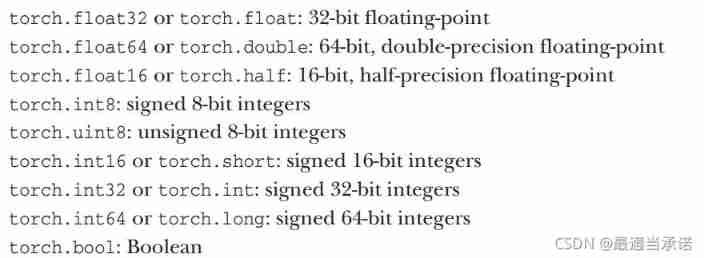
points_t = torch.tensor([4.0, 1.0, 5.0],dtype=torch.float)
a = [4.0, 1.0, 5.0]
a_t = torch.tensor(a,dtype=torch.float)
# it means we could convert the numpy array into the tensor type
# by torch.tensor(numpy_array)
# in this way, we could copy the data from the numpy to tensor
# if we do not want to keep the numpy array, we could use:
# torch.as_tensor(numpy) there is no copy.
# the numpy and the tensor have the same memory space.
# Notice: you have to convert the tensor from the numpy array
a = numpy.array([1,2,3])
t = torch.as_tensor(a)
# t and a have the same memory space, rather than copy
a_t.shape # torch.size(3)
a_t.dtype
double_a_t = a_t.double()
# "to" method
double_a_t = a_t.to(torch.double)
short_a_t = a_t.to(torch.short)
Indexing tensors
points_t = torch.tensor( [ [0.,1.],[2.,3.],[4.,5.] ] ) # 2D tensor
points_t[0,1] # tensor(1.0)
points_t[0] # tensor([0.,1.])
points_t[:,1] # tensor([1.,3.,5.])
a_t = torch.tensor([0.,1.,2.,3.,4.,5.,6.])
a_t[:] # all
a_t[1:4] # from the element 1 inclusive to the element 4 exclusive
a_t[1:] # from the element 1 inclusive to the last element
a_t[:4] # from the start of the list to the element 4 exclusive
a_t[:-1] # exclusive the end element
a_t[0:6:2] # from element 0 inclusive to the element 6 exclusive in steps of 2
for multi-dimensional tensor:
points_t = torch.tensor( [[0.,1.,2.],[3.,4.,5.],[6.,7.,8.]] )
points_t[ 1: , : ] # all rows after the first, all columns
points_t[ 1: , 0 ] # all rows after the first, the first column
points_t[ None ] # add a dimension, like "unsqueeze"
# tensor([[[0., 1., 2.],[3., 4., 5.],[6., 7., 8.]]])import torch
a_t = torch.ones(3) # one-dimensional tensor: 1X3 [1.0, 1.0, 1.0]
a_t[1] # tensor(1.0)
float(a_t[1]) # 1.0 convert the tensor type into the float type
a_t = torch.randn(3,5,5) #shape[channel, rows, columns]
# or torch.randn((3,5,5))
a_t.mean(-3) # means of channels, the shape of the output is [5,5]
# -3 means the columns counting from the end
Math ops
pointwise ops
Boardcasting in the Numpy is also suitbale to Pytorch. Broadcasting — NumPy v1.21 Manual
in order to contorl the diemnsion of the tensor more easilier, we use the name tensor.
(prototype) Introduction to Named Tensors in PyTorch — PyTorch Tutorials 1.10.0+cu102 documentation
import torch
imgs_t = torch.randn(1,2,2,3,names=('NUMBER','CHANNEL','HEIGHT','WIDTH'))
# names defines the size of every dimension in the tensor
# property
imgs_t.names # ('NUMBER','CHANNEL','HEIGHT','WIDTH')
# Rename
# it will not change the dimension, just change the name of the 'label'
# method 1:
imgs_t.names = ['N','C','H','W']
# method 2:
imgs_t = imgs_t.rename( NUMBER='N',CHANNEL='C' )
# arbitary number of names could be changed
imgs_t.rename(None) # cancel all names
# method 3:
imgs = torch.randn(3,1,1,2)
named_imgs = imgs.refine_names('N','C','H','W')
# in this way, we could obtain the tensor with or without name at the same time
In different tensor, we could use the same label to name the dimension, however, it's not a good way. Because when we operate the tensors between them, the dimensions with same name should be same, otherwise, there is error.
Align_as can achieve the sorting of the dimensions. If we want to change the sorting of dimensions in tensor A matching tensor B (boardcasting can work by the name label), it will help us.
b_t = torch.tensor([[1.0,2.0],[3.0,4.0]],names=('H','W'))
c_t = torch.tensor([[5.0,6.0],[7.0,8.0]],names=('W','H'))
c_t = c_t.align_as(b_t)
# the content of c_t will be changed into the order of the name label in b_t
x = torch.randn(2,3,4,5,names=('N','C','H','W'))
y = x.align_to(...,'W','H')
print(y.shape)
print(y.names)
# result
# torch.Size([2, 3, 5, 4])
# ('N', 'C', 'W', 'H')
Operator
imgs.abs().names # it is the same as original imgs before abs operator
# operator will not change the names property output = imgs.sum('C')
# we could use the name label to specify the positional dimension
# rather than -1,-2....
img0 = imgs.select('N',0)
Operator between matrices
markov_states = torch.randn(128, 5, names=('batch', 'D'))
transition_matrix = torch.randn(5, 5, names=('in', 'out'))
# Apply one transition
new_state = markov_states @ transition_matrix
print(new_state.names)
# result:
# ('batch', 'out')dimension reshape
a_t = torch.randn(2)
b_t = a_t.view(2,1,1,1) # which could change the dimension as whay we want.
a_t.torch.randn(2,8)
b_t = a_t.view(-1,1)
# size will be 16X1, the size -1 is inferred from other dimensions
x_t = torch.randn(2,3,4,5)
y_t = torch.transpose(x_t,1,2) # transpose will swap two dimensional position
y_t.shape
# result
[2,4,3,5]imgs = torch.randn(2, 2, 2, 2, names=('N', 'C', 'H', 'W'))
imgs = imgs.flatten(['C', 'H', 'W'], 'features') # flatten the tensor
print(imgs.names)
imgs = imgs.unflatten('features', (('C', 2), ('H', 2), ('W', 2)))
# unflatten the tensor
print(imgs.names)frequent usage
# no grad in this section
with torch.no_grad():Activation function
import torch.nn as nn
nn.Tanh()
nn.SIgmoid()
nn.ReLU()
nn.Softplus()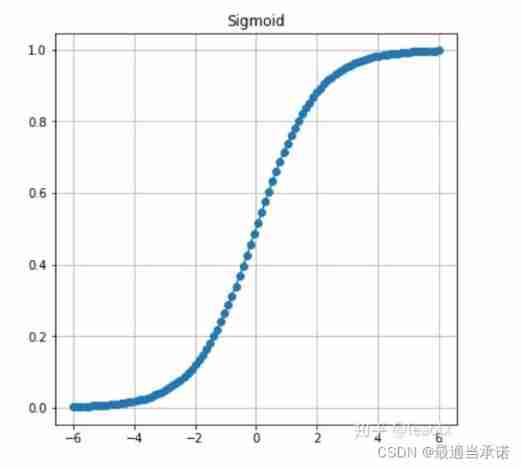



Function:
define the full connected layers by the input dimension, the hidden dimension, activation function, the output dimension, the output activation function
"""
function: define the fully connected layers in the function
Args:
input dim:(integer) the dimension of the input
hidden_size:(tuple) the dimension of every hidden layers, such as (3,3), (3,4)
activation:(module) activation function in the hiden layers, MUST be the format of nn.Relu, rather than nn.ReLU().
output_dim:(integer) the dimension of the output
output_activation:(module) activation function after the output layer, MUST be the format of nn.Relu, rather than nn.ReLU(). Usually, we could use nn.Identity(default function) to change nothing.
"""
import torch
import torch.nn as nn
import numpy as np
class fcl(nn.Module)
def __init__(input_dim: int ,hidden_size: tuple, activation=nn.ReLU, output_dim:int, output_activation=nn.Identity ):
super().__init__()
size = [input_dim]+ list(hidden_size)+ [output_dim]
layers = []
for num in range(len(size)-1):
activate = activation if num < len(size)-2 else output_activation
layers += [nn.linear(size[num],size[num+1]), activate()]
self.fc = nn.Sequential(*layers)
def forward(self,obs):
return self.fc(obs)
#use:
fc = fcl(4,(3,3),nn.ReLU,2,nn.Tanh)
Commonly used libraries
nn.Module
"""
With nn.Module Class created for parent class model
Will be generated automatically nn.Module Functions and features in
"""
"""
class fc(nn.Module)
def __init__(self):
super().__init__()
model = fc()
"""
1. # All relevant iteration parameters will be obtained
model.parameters()
"""
Avoid meaningless grad Calculation
for p in model.parameters():
p.requires_grad = False
"""边栏推荐
- Open Euler Kernel Technology Sharing - Issue 1 - kdump Basic Principles, use and Case Introduction
- The new series of MCU also continues the two advantages of STM32 product family: low voltage and energy saving
- Leetcode - 933 number of recent requests
- LeetCode - 1670 設計前中後隊列(設計 - 兩個雙端隊列)
- CV learning notes - Stereo Vision (point cloud model, spin image, 3D reconstruction)
- Swing transformer details-1
- LeetCode - 703 数据流中的第 K 大元素(设计 - 优先队列)
- 20220603数学:Pow(x,n)
- Vscode markdown export PDF error
- Opencv note 21 frequency domain filtering
猜你喜欢
![[combinatorics] Introduction to Combinatorics (combinatorial idea 3: upper and lower bound approximation | upper and lower bound approximation example Remsey number)](/img/19/5dc152b3fadeb56de50768561ad659.jpg)
[combinatorics] Introduction to Combinatorics (combinatorial idea 3: upper and lower bound approximation | upper and lower bound approximation example Remsey number)

Serial communication based on 51 single chip microcomputer
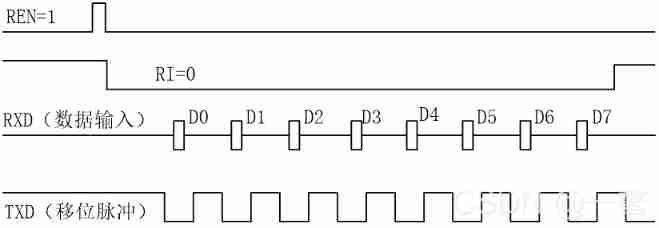
Working mode of 80C51 Serial Port

Yocto Technology Sharing Phase 4: Custom add package support

Leetcode - 933 number of recent requests
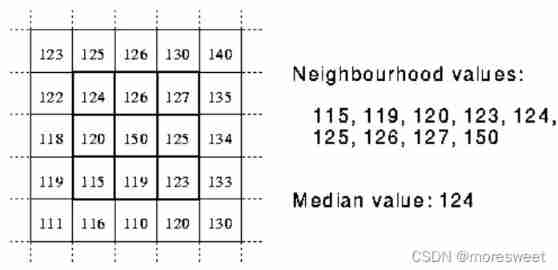
CV learning notes - image filter

LeetCode - 673. Number of longest increasing subsequences

Opencv Harris corner detection

LeetCode - 1670 设计前中后队列(设计 - 两个双端队列)
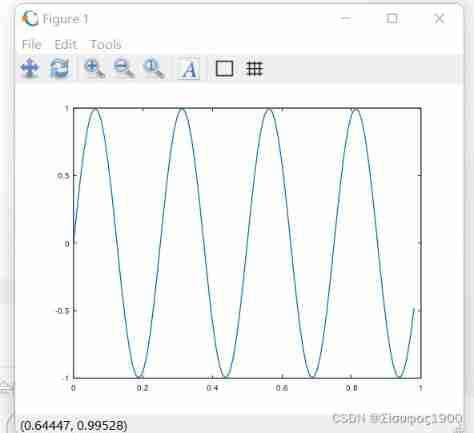
Octave instructions
随机推荐
2312、卖木头块 | 面试官与狂徒张三的那些事(leetcode,附思维导图 + 全部解法)
2. Elment UI date selector formatting problem
MySQL root user needs sudo login
RESNET code details
Stm32 NVIC interrupt priority management
LeetCode - 508. Sum of subtree elements with the most occurrences (traversal of binary tree)
Gif image analysis drawing RGB to YUV table lookup method to reduce CPU occupancy
Circular queue related design and implementation reference 1
Qcombox style settings
03 FastJson 解决循环引用
(2) New methods in the interface
2021-11-11 standard thread library
4G module board level control interface designed by charging pile
STM32 general timer 1s delay to realize LED flashing
Connect Alibaba cloud servers in the form of key pairs
QT is a method of batch modifying the style of a certain type of control after naming the control
LeetCode - 5 最长回文子串
(1) What is a lambda expression
01 business structure of imitation station B project
[combinatorics] combinatorial existence theorem (three combinatorial existence theorems | finite poset decomposition theorem | Ramsey theorem | existence theorem of different representative systems |